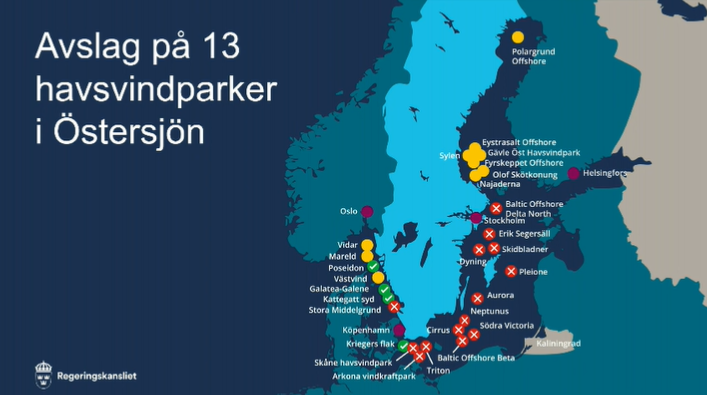The Swedish government has rejected 13 applications to construct offshore wind farms in the Baltic Sea due to defense concerns, while approving one project on the west coast, developed by Vattenfall and Zephyr.
On November 4, the Swedish government announced the rejection of 13 applications to build offshore wind farms in the Baltic Sea, south of the Sea of Åland, which had a potential capacity of nearly 32 GW.
“Based on the Armed Forces’ documentation, the government assesses that constructing these projects would have unacceptable consequences for Sweden’s military defense. In the current serious security situation, with conflict in our immediate area, defense interests must be prioritized,” said Pål Jonson, Sweden’s Minister of Defence.
The government denied OX2’s 5.5 GW Aurora, 3.1 GW Neptunus, 1 GW Pleione, and 1.4 GW Triton projects. Eolus also had two projects denied: 1.4 GW Arkona and 2.2 GW Skibladner.
Sweden also rejected applications from Denmark’s Ørsted for the 1.5 GW Skåne project, RWE’s 2 GW Södra Victoria, Statkraft’s 2.5 GW Baltic Offshore Beta, and 2.1 GW Baltic Offshore Delta North projects.
Proposals from Freja Offshore, a joint venture between Hexicon and Mainstream Renewable Power, part of the Aker Group, were also denied, affecting the Cirrus and Dyning floating offshore wind projects. Dyning was planned to be located southeast of Oxelösund, and Cirrus was to be south of Karlskrona.
Freja Offshore is developing the Mareld floating wind farm off Sweden’s west coast, which received a recommendation from the County Administrative Board of Västra Götaland and is under government review.
Another rejected proposal was from Deep Wind Offshore for the Erik Segersall offshore wind project.
According to the government, the Poseidon project on the west coast, expected to generate about 5.5 TWh of electricity annually, was the only approved wind farm. Vattenfall and Zephyr, with Vattenfall as the majority owner, plan to start construction in 2029, aiming for completion by 2031.
Original Story at www.offshorewind.biz
